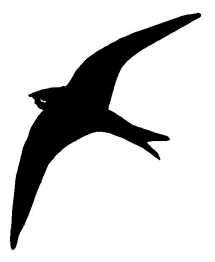
Back to the Annual Report Contents and Home page

Since 1996 I have been observing and recording Slingsby’s swifts. Of the summer migrants that come to Britain each year, the swift is not only mine, but one of others’ favourite birds. Chasing each other around, often in formation, early on a summer’s evening, their screaming and screeching is a memorable sight and sound. Their rapid wing beats and flight speed is exceptional and it is not without reason they are sometimes called ‘nature’s arrows’, with their swept back, sickle-shaped wings, dark underparts and a paler chin. Most people have no difficulty in recognising the common swift Apus apus. Occasionally an alpine swift Apus melba, with its white underbelly, turns up in Britain.
On average the first arrivals in Slingsby are during the second week of May, but since 2001 swifts have been arriving during the last few days of April or the beginning of May, indicating, maybe, the effects of climate change. By the end of May, most of the local Slingsby swifts, of which there are between 12 to 20 pairs, have established themselves. Swifts, like some bat species, show a high level of philopatry or love of home, for ringing returns indicate that the same birds return to the same nesting site year after year.

Most of the houses in the central core of the village were built in the 1850s, especially along Railway Street. Many of these houses have retained their red Yorkshire pantile roofs, especially at the northern end of Railway Street. More often than not, there is no roofing felt. The swifts are able to exploit the situation. In places, an ill-fitting tile makes an excellent access point to a simple ceiling nesting site below the lower edge of the roof and gutter. On one such house there are five such access points and adult swifts, later in the season, can be seen bringing food to their young. Over the years there have been a number nesting casualties: for example, a late hatchling fell out of a nest on 1st August and an adult with a fractured wing was found on 16th July.
 Neither survived; the adult, although hand fed, never was able to fly. Swifts have primitive feet that make walking and clinging difficult. The screaming tells other swifts of the presence of a colony, as well as communication between males and females. During heavy rain, as experienced in 2007, swifts seem to disappear, but return within a few days.
Neither survived; the adult, although hand fed, never was able to fly. Swifts have primitive feet that make walking and clinging difficult. The screaming tells other swifts of the presence of a colony, as well as communication between males and females. During heavy rain, as experienced in 2007, swifts seem to disappear, but return within a few days.
By mid-July, during warm sultry conditions, over a hundred pre-migration swifts can be seen in the skies above Slingsby, often with an influx of birds from elsewhere, indicating there is an adequate insect prey level for them to feed off. The last swifts leave the village during the last two weeks of August, with individual stragglers departing in the first two weeks of September. British Trust for Ornithology returns indicate the swift population in Britain is stable, but concern has been expressed over the loss of suitable house loft space nesting sites, as older houses in villages such as ours are upgraded.
Photo © Michael Thompson 2008; drawings © Rhona Sutherland 2009; text © Ryedale NHS 2009
Back to the Top, Annual Report Contents and Home page